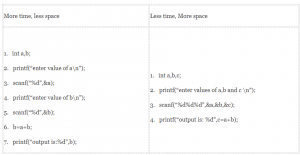Let’s learn about Time–Space trade off , what is needed for a time-space trade-off?
Definition:-
A space-time or time-memory trade-off in computer science is a way of solving a problem in:-
- Less time by using more memory
- By solving in very little space by spending a long time.
Example

Types of Time-Space Trade-off
- Lookup vs. recalculation
- Compressed vs. uncompressed
- Re-rendering vs. stored images
- Smaller code vs. loop unrolling
- Lookup vs. recalculation
An algorithm involving a lookup table is an implementation can include the entire table, which reduces computing time, but increases the amount of memory needed, or it can compute table entries as needed, increasing computing time, but reducing memory requirements.
- Compressed vs. uncompressed
The problem of data storage can also be handled by using space and time tradeoff of algorithms. If data is stored is not compressed, it takes more space but access takes less time than if the data were stored compressed (since compressing the data reduces the amount of space it takes, but it takes time to run the decompression algorithm). It is depending upon the particular instance of the problem, either way is practical. There are also rare instances where it is possible to directly work with compressed data, such as in the case of compressed bitmap indices, where it is faster to work with compression than without compression.
- Re-rendering vs. stored images
In this case, storing only the SVG source of a vector image and rendering it as a bitmap image every time the page is requested would be trading time for space; more time used, but less space. Rendering the image when the page is changed and storing the rendered images would be trading space for time; more space used, but less time. This technique is more generally known as caching.
- Smaller code vs. loop unrolling
This technique is commonly used to makes the code longer for each iteration of a loop, but it saves the computation time required for jumping back to the beginning of the loop at the end of each iteration. Larger code size can be traded for higher program speed when applying loop unrolling
I hope guys like and comment this Time–Space trade off
Read more about Data Structures
Introduction to data structures
Long time supporter, and thought I’d drop a comment.
This website is very good and I like this website.
I just launched my site –also built in wordpress like yours– but the theme slows (!)
the site down quite a bit.
In case you have a minute, you can find it by searching
for “royal cbd” on Google (would appreciate any feedback) – it’s still in the works.
Keep up the good work– and hope you all take care of yourself during the
coronavirus scare!
Thank you for sharing this article with me. It helped me a lot and I love it.
I really appreciate your help
Thank you for your articles. They are very helpful to me. May I ask you a question?
yes
Thanks for your help and for writing this post. It’s been great.
I have been browsing on-line more than three hours today, but I never found any fascinating article like yours. It is lovely price sufficient for me. Personally, if all web owners and bloggers made excellent content material as you probably did, the internet shall be much more useful than ever before.
Awesome blog! Do you have any recommendations for aspiring writers? I’m hoping to start my own site soon but I’m a little lost on everything. Would you advise starting with a free platform like WordPress or go for a paid option? There are so many choices out there that I’m totally overwhelmed .. Any suggestions? Cheers!